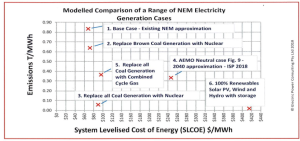The real cost of backing up the intermittent provision of wind and solar power has been spelled out in a comprehensive model that has achieved virtually no coverage in the public discussion of energy issues. This is a scandalous situation that reflects the ignorance and virtually criminal negligence of the journalists and commentators of the nation. This is a short version of the report.
According to all the people who are supposed to know about these things the road to net zero is clear and the days of the coal power are numbered because wind and solar power are so much cheaper. How much cheaper? Well the inputs of wind and sunbeams come free of charge, so how much cheaper can you get!
The CSIRO GenCost study is regarded as the last word on the matter and who can challenge the authority of the CSIRO? It is disappointing to find that the study is full of holes and dubious assumptions. The biggest hole of all is the failure to account for the full cost of firming the intermittent inputs. This is currently provided by the much maligned coalers and it comes free of charge to the wind and solar industries. See here for the frog and centipede relationship between conventional power and the predatory parasites of the RE industry.
In November 2020 a group of consultants tabled a report in the NSW Parliament with the results of some elaborate modelling work to generate the total System Levelised Cost of Energy (SLCOE) which is defined as — “…the average cost of producing electric energy from the combination of generation technologies chosen for the system over its entire lifetime”
The models include additional transmission costs for various options including replacing brown coal with nuclear energy, replacing coal with gas and 100% RE with hydro and storage.
SUMMARY OF RESULTS

The best policy option to control costs and minimise emissions would appear to be to replace coal generation with nuclear power.
Case 1. This is the current situation, with over 70% of power generated by coal the estimated cost is $68.87/MWh.
Case 2 shows the effect of introducing 3,000 MW of nuclear power capacity into the Case 1 mix to replace brown coal. This raises the cost to $72.48/MWh while reducing emissions by around 23%.
Case 3 shows the effect of replacing all coal in Case 1 with nuclear power. Emissions fall by some 93%, with the cost increasing to $90.23/MWh.
Case 4 shows the effect of the combination of generation technologies projected by the Australian Energy Market Operator (AEMO) to 2040, as shown in its Integrated System Plan (ISP) of July 2018. The cost is in the order of $250/MWh.
Case 5 shows the effect of replacing all coal in Case 1 with CCGT. This shows an increase in cost to approach $100/MWh.
Case 6 shows a 100% renewable mix comprising solar PV, wind and hydro with support from pumped storage and some battery storage. Because of low capacity factors, solar PV and wind require a combined total of 110,000 MW of capacity.T here is also a need for 30,000 MW of pumped storage capacity for 3 days. To this must be added high-cost additional transmission to get the power to points of high consumption where it is needed, making a total SLCOE of $415.50 I MWh.
Supporting information. All key technology performance data, costs, and other relevant information are listed at the Power System Generation Mix Model website.
SUPPLEMENTARY INFORMATION & COMMENTS FROM THE AUTHORS
1. Wind-up subsidies for intermittent power generation
2. Add a capacity market component to the National Electricity Market
The current NEM is an energy-only market, which does not give clear signals when more or replacement dispatchable generation investment is needed. This weakness has been a key factor in the current absence of new dispatchable investment, i.e. power which can be delivered at the time it is needed by customers.
3. Remove the ban on nuclear power
This ban is the result of a political deal done 20 years ago. It has no scientific merit and is now an obstacle to much-needed decisions for the longer-term future. It prohibits by law the development of emissions-free, reliable, affordable nuclear power for Australia. The removal of the ban would allow more competition between various technologies to supply our future electricity needs.